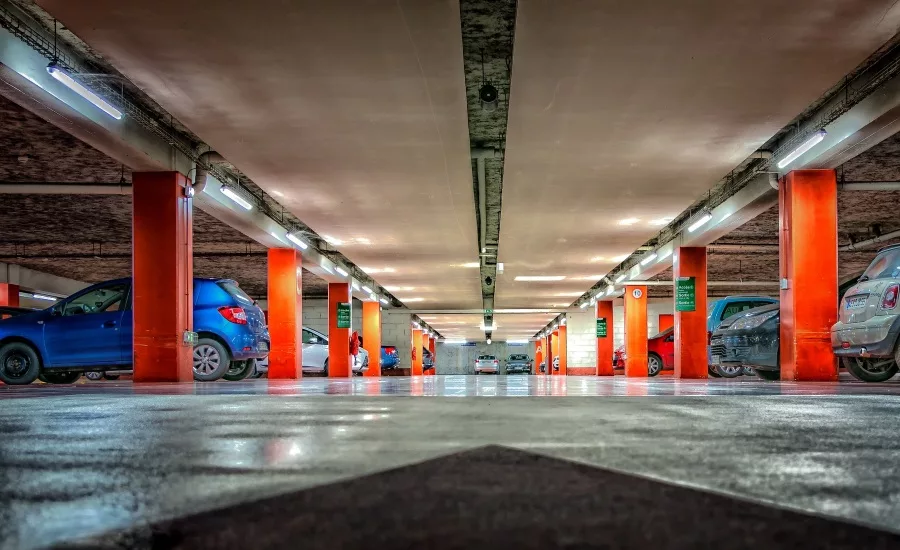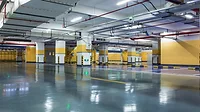Auto-pedestrian safety in parking garages

Security managers and risk managers have always been aware of injuries and deaths in parking garages caused by assaults and vehicles. What is shocking is that there is only a miniscule amount of data on injuries and deaths in parking garages. OSHA does not even track work-related injuries or deaths of employees caused by auto-pedestrian crashes in garages. The private business sector has little incentive to track injuries and deaths caused by reckless drivers in their parking garages. Many businesses purposely do not record data on auto-pedestrian incidents in their garages out of business concerns.
In a 2002 study, over a 10-year period, Gregory Fayard, U.S. Bureau of Labor Statistics, estimated that approximately 3% of all workplace injuries and deaths occur in parking garages. Of the 206 annual employee fatalities, 15% of these —31 deaths a year — are pedestrian employees killed by reckless drivers. Some experts estimate that up to 500 pedestrians are killed every year in parking garages in the United States.
Pedestrian-auto injuries and fatalities in parking garages can be broken down into three categories of causation: driver distraction, driver impairment, and driver recklessness (usually speeding).
With the advent of technology and saturation of smart phones in our society, there has been a substantial uptick in auto-pedestrian injuries and fatalities on public roadways and in parking garages. Driver distraction in parking garages is well-documented. In a Distracted Driving public opinion poll in March 2016 conducted by the National Safety Council, 66% of drivers admitted to using their cell phones and 56% admitted to texting while driving through parking lots and parking garages. Cell phone use and texting greatly reduce a driver’s ability to observe and avoid striking pedestrians.
Risk mitigation
Simple approaches with high-visibility LED signs reminding drivers to “Watch for Pedestrians” and urging drivers to “Drive and Don’t Text” can be utilized as risk mitigation tools for distracted drivers.
In addition, increasing lighting will help make pedestrians more visible when walking down parking aisles. The use of LED flashing lights at pedestrian crossings is another tool.
Security leaders and facilities management must take a more aggressive approach with reckless drivers who speed and race through parking garages. The following mitigation enforcement tools can be utilized to inhibit speeding through parking garages:
- Increased security patrols.
- Utilization of law enforcement officers to supplement private security in parking garages.
- Increased lighting throughout the parking garage.
- Installation of LED signs warning pedestrians to “watch for speeding vehicles.”
- Installation of high-visibility LED lights, signs, and painted crosswalks in areas where pedestrians must cross vehicular traffic lanes.
- Installation of closed-circuit camera (CCTV) systems with high-resolution license plate capture capability with signage at all entrances, exits, and all pedestrian crosswalks.
- Closing off access to parking garages after business hours with gates or barricades.
- Installation of highly visible painted speed bumps strategically placed on long parking aisles, all ramps, and at all pedestrian crossing points.
Property owners have a legal duty to warn customers of latent dangers and defects in their parking garages. They have a duty to take reasonable steps to eliminate these defects and dangerous activities. Commercial property owners should not ignore these safety issues of racing, speeding, impaired and distracted drivers, which are present in all parking garages.
Dealing with reckless drivers
Dealing with impaired and reckless drivers who speed through parking garages for fun to engage in competition racing or for “drifting” require special attention.
“Drifting” is a driving technique in which the driver oversteers, after accelerating to a high speed, and purposefully loses wheel traction to slide and “drift” while going through serpentine courses, such as multi-level parking garages. Drifting started in Japan in the 1970s and became popular in California parking garages around 2000. Drifting and racing in parking garages has spread from California throughout the United States in the past 20 years. This practice has increased in popularity with racing movies such as Fast and Furious. In the movie Fast and Furious- Tokyo Drift parking garage racing or drifting is a central theme in the movie.
Hiring additional security patrols or police officers is expensive and may not stop speeding or reckless drivers unless personnel are maintained in the parking garage during business hours. Signs, alone, may not have much of an effect on impaired or reckless drivers.
However, there is one deterrent to speeding and reckless drivers that is inexpensive and effective — speed bumps. Speed bumps have been proven to significantly reduce vehicular speed on public roads, parking lots, and parking garages. Speed bumps are an incredibly effective deterrent to speeding and “drifting” vehicles in parking garages.
Many cars used by “drifting” drivers are smaller foreign car vehicles or American cars with modified engines and suspensions. Many of these cars have suspensions that been dropped or lowered to increase their stability by lowering their center of gravity. The drivers who like to drift through parking lots and garages rely on smooth uninterrupted roadways or aisles to get the high speed they need to slide, skid, and drift. The implementation of rubber or concrete speed bumps in parking garages will slow all traffic down to a safe speed, thus, offering a further layer of protection for pedestrians.
Looking for a reprint of this article?
From high-res PDFs to custom plaques, order your copy today!





